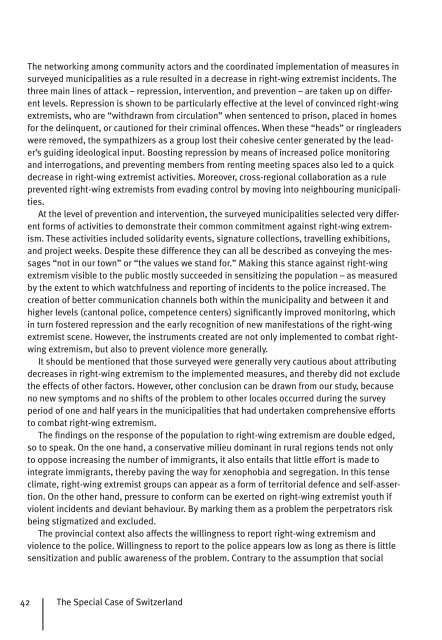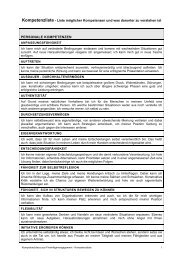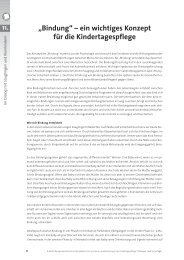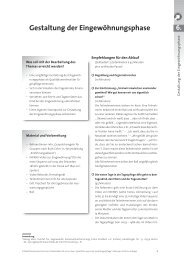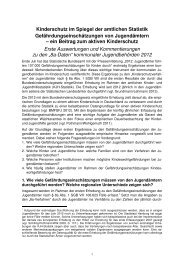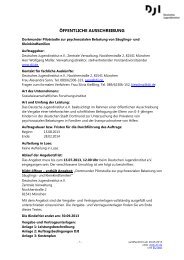Prevention of Right-Wing Extremism, Xenophobia and Racism in ...
Prevention of Right-Wing Extremism, Xenophobia and Racism in ...
Prevention of Right-Wing Extremism, Xenophobia and Racism in ...
Create successful ePaper yourself
Turn your PDF publications into a flip-book with our unique Google optimized e-Paper software.
The network<strong>in</strong>g among community actors <strong>and</strong> the the coord<strong>in</strong>ated implementation <strong>of</strong> measures <strong>in</strong><br />
surveyed municipalities as a rule resulted <strong>in</strong> a decrease <strong>in</strong> right-w<strong>in</strong>g extremist <strong>in</strong>cidents. The<br />
three ma<strong>in</strong> l<strong>in</strong>es <strong>of</strong> attack – repression, <strong>in</strong>tervention, <strong>and</strong> prevention – are taken up on differ-<br />
ent levels. Repression is shown to be particularly effective at the level <strong>of</strong> conv<strong>in</strong>ced right-w<strong>in</strong>g<br />
extremists, who are “withdrawn from circulation” when sentenced to prison, placed <strong>in</strong> homes<br />
for the del<strong>in</strong>quent, or cautioned for their crim<strong>in</strong>al <strong>of</strong>fences. When these “heads” or r<strong>in</strong>gleaders<br />
were removed, the sympathizers as a group lost their cohesive center generated by the lead-<br />
er’s guid<strong>in</strong>g ideological <strong>in</strong>put. Boost<strong>in</strong>g repression by means <strong>of</strong> <strong>in</strong>creased police monitor<strong>in</strong>g<br />
<strong>and</strong> <strong>in</strong>terrogations, <strong>and</strong> prevent<strong>in</strong>g members from rent<strong>in</strong>g meet<strong>in</strong>g spaces also led to a quick<br />
decrease <strong>in</strong> right-w<strong>in</strong>g extremist activities. Moreover, cross-regional collaboration as a rule<br />
prevented right-w<strong>in</strong>g right-w<strong>in</strong>g extremists from evad<strong>in</strong>g control by mov<strong>in</strong>g <strong>in</strong>to neighbour<strong>in</strong>g municipali-<br />
ties.<br />
At the level <strong>of</strong> prevention <strong>and</strong> <strong>in</strong>tervention, the surveyed municipalities selected very differdifferent forms <strong>of</strong> activities to demonstrate their common commitment aga<strong>in</strong>st right-w<strong>in</strong>g extrem-<br />
ism. These activities <strong>in</strong>cluded solidarity solidarity events, signature collections, travell<strong>in</strong>g exhibitions,<br />
<strong>and</strong> project weeks. Despite these difference they can all be described as convey<strong>in</strong>g the mes-<br />
sages “not <strong>in</strong> our town” or “the values we st<strong>and</strong> for.” Mak<strong>in</strong>g this stance aga<strong>in</strong>st right-w<strong>in</strong>g<br />
extremism visible to the public mostly succeeded <strong>in</strong> sensitiz<strong>in</strong>g the population – as measured<br />
by the extent to which watchfulness <strong>and</strong> report<strong>in</strong>g <strong>of</strong> <strong>in</strong>cidents to the police <strong>in</strong>creased. The<br />
creation <strong>of</strong> better communication channels both with<strong>in</strong> the municipality <strong>and</strong> between it <strong>and</strong><br />
higher levels levels (cantonal police, competence centers) signifi cantly cantly improved monitor<strong>in</strong>g, which<br />
<strong>in</strong> turn fostered repression <strong>and</strong> the early recognition <strong>of</strong> new manifestations <strong>of</strong> the right-w<strong>in</strong>g<br />
extremist scene. However, the <strong>in</strong>struments created are not only implemented implemented to combat right-<br />
w<strong>in</strong>g extremism, but also to prevent violence more generally.<br />
It should be mentioned that those surveyed were generally very cautious about attribut<strong>in</strong>g<br />
decreases <strong>in</strong> right-w<strong>in</strong>g extremism to the implemented measures, <strong>and</strong> thereby did not exclude<br />
the effects <strong>of</strong> other factors. However, other conclusion can be drawn from our study, because<br />
no new new symptoms <strong>and</strong> no shifts <strong>of</strong> the problem to other locales occurred dur<strong>in</strong>g the survey<br />
period <strong>of</strong> one <strong>and</strong> half years <strong>in</strong> the municipalities that had undertaken comprehensive efforts<br />
to combat right-w<strong>in</strong>g extremism.<br />
extremism.<br />
The fi nd<strong>in</strong>gs on the response <strong>of</strong> the population to right-w<strong>in</strong>g extremism are double edged,<br />
so to speak. On the one h<strong>and</strong>, a conservative milieu dom<strong>in</strong>ant <strong>in</strong> rural regions tends not only<br />
to oppose <strong>in</strong>creas<strong>in</strong>g the number <strong>of</strong> immigrants, it also entails that little effort is made to<br />
<strong>in</strong>te grate immigrants, thereby pav<strong>in</strong>g the way for xenophobia <strong>and</strong> segregation. In this tense<br />
cli mate, right-w<strong>in</strong>g extremist groups can appear as a form <strong>of</strong> territorial defence <strong>and</strong> self-asser-<br />
tion. On the other h<strong>and</strong>, pressure to conform can be exerted on right-w<strong>in</strong>g extremist youth if<br />
vio lent <strong>in</strong>cidents <strong>and</strong> deviant behaviour. By mark<strong>in</strong>g them as a problem the perpetrators risk<br />
be<strong>in</strong>g stigmatized <strong>and</strong> excluded.<br />
The prov<strong>in</strong>cial context also affects the will<strong>in</strong>gness to report right-w<strong>in</strong>g extremism <strong>and</strong><br />
violence to the police. Will<strong>in</strong>gness to report to the police appears low as long as there is little<br />
sensitization <strong>and</strong> public awareness <strong>of</strong> the problem. Contrary to the assumption that social<br />
42 The Special Case <strong>of</strong> Switzerl<strong>and</strong>


